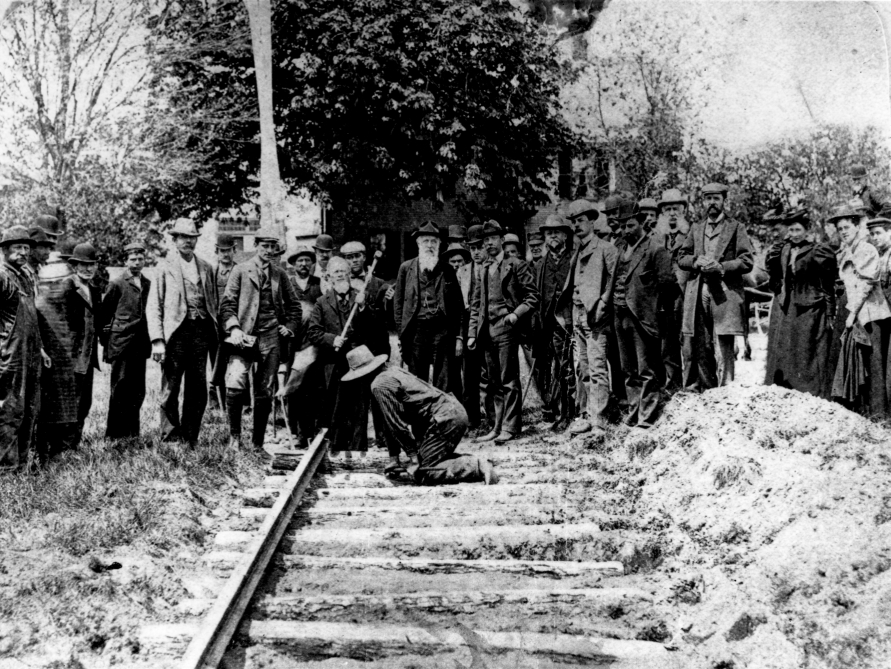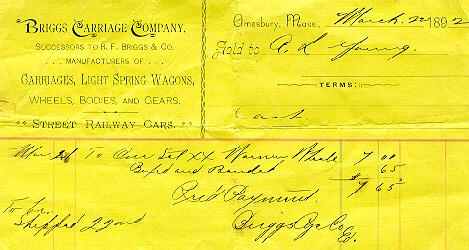By John M. Holman, Contributing Writer

of the street railroad, Toppan Farm in the background.
It was May 19, 1897 at 10:30 in the morning in Hampton, when the first spike was driven for the Electric Railway which was to be in operation for 29 years before complete abandonment in 1926.
The trolley line, at first called the EXETER STREET RAILWAY, later to become consolidated into the EXETER, HAMPTON & AMESBURY STREET RAILWAY COMPANY (commonly referred to as the “EH&A” at the time), connected the towns of Exeter and Hampton with the famous Hampton Beach. It was completed on July 3, 1897.
This line gave “the inhabitants of these and the surrounding towns, as well as visitors, a quick and pleasant access by well-built, open and closed cars, to one of the most beautiful seaside resorts on the entire Atlantic coast, at a very moderate cost.” (– The Hamptons Union — 1899)
The laying of the first rail and spike took place on May 19, 1897, on Winnacunnet Road at “Whittier Junction” just easterly of the Galley Hatch Restaurant. Driving the first spike was Judge Charles M. Lamprey, on which occasion he addressed the assembled crowd of the two towns of Exeter and Hampton, and said in substance:
and Report envelope, ca. 1915.
“This is one of the most important events in the history of Hampton. One hundred years ago this present week, the people of Hampton assembled on the spot where now stands the Town Hall for the erection of a town church.(Ed.: This was the fifth meeting house, later became the Town Hall which burned on March 19, 1949 and was never rebuilt.)
“Eighty-two years ago this month, the people again assembled at this noted corner, which had been a wayside inn for over 100 years, for the raising of the present hotel. (Ed.: He was referring to the Hotel Whittier, built in 1817 and burned January 12, 1917; cause: “rats and matches, according to the Hampton Town Report.”) Fifty-four years ago the present month, on the spot where the present Congregational Church stands, the church was raised for the oldest Congregational Society in New Hampshire.
“Today we assemble again to celebrate the most important of all events in the town’s history, the commencement of this town’s connection with Exeter, the shire town of the county.
“Hampton was settled by Stephen Bachiler in 1638, and Exeter by John Wheelwright in the same year. At that time, the only way between Exeter and Hampton was the Indian trail, the same route that this road of steel now passes.
“It now becomes my pleasure, at the request of the Exeter Street Railway officials, to drive the first spike on this road, which I do, wishing more prosperity than ever for Exeter and Hampton, which the steel rails will soon connect.”
A section of this trolley rail and spikes are on permanent display at the TUCK MEMORIAL MUSEUM at 40 Park Avenue, Hampton, in a section called, “THE TROLLEY ERA OF HAMPTON — 1897 – 1926.” Many other relics from the trolley era are also on display in the museum.
Briggs was a principal maker of trolley cars for the Exeter, Hampton &
Amesbury Street Railway during its heyday.
[Courtesy of Lynn A. Davis]

[Courtesy of John & Connie Holman]

